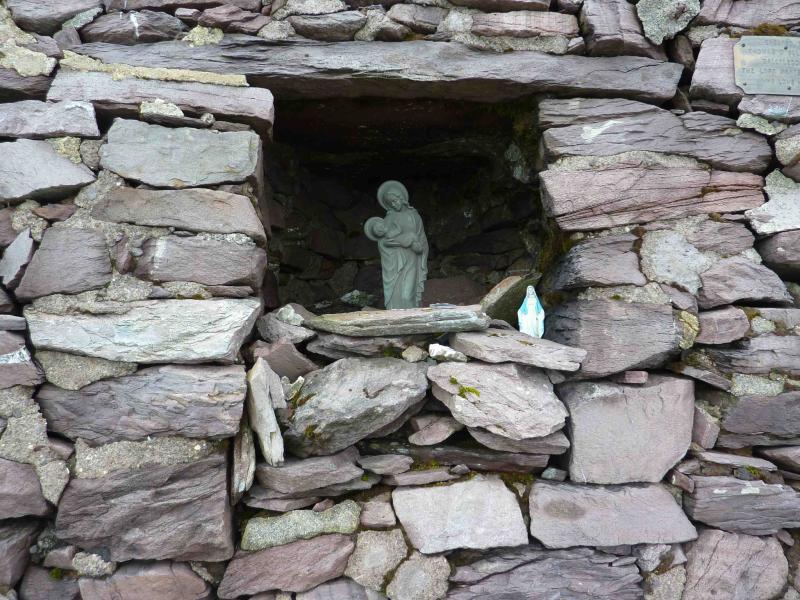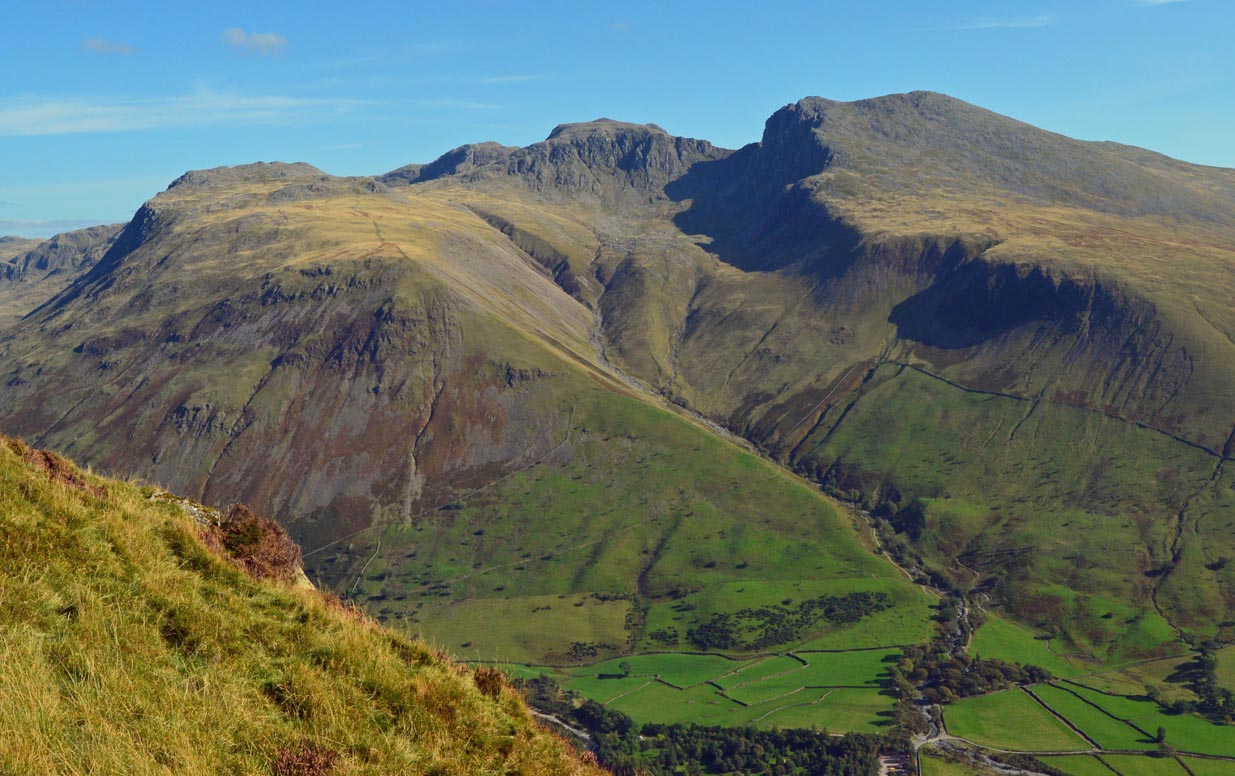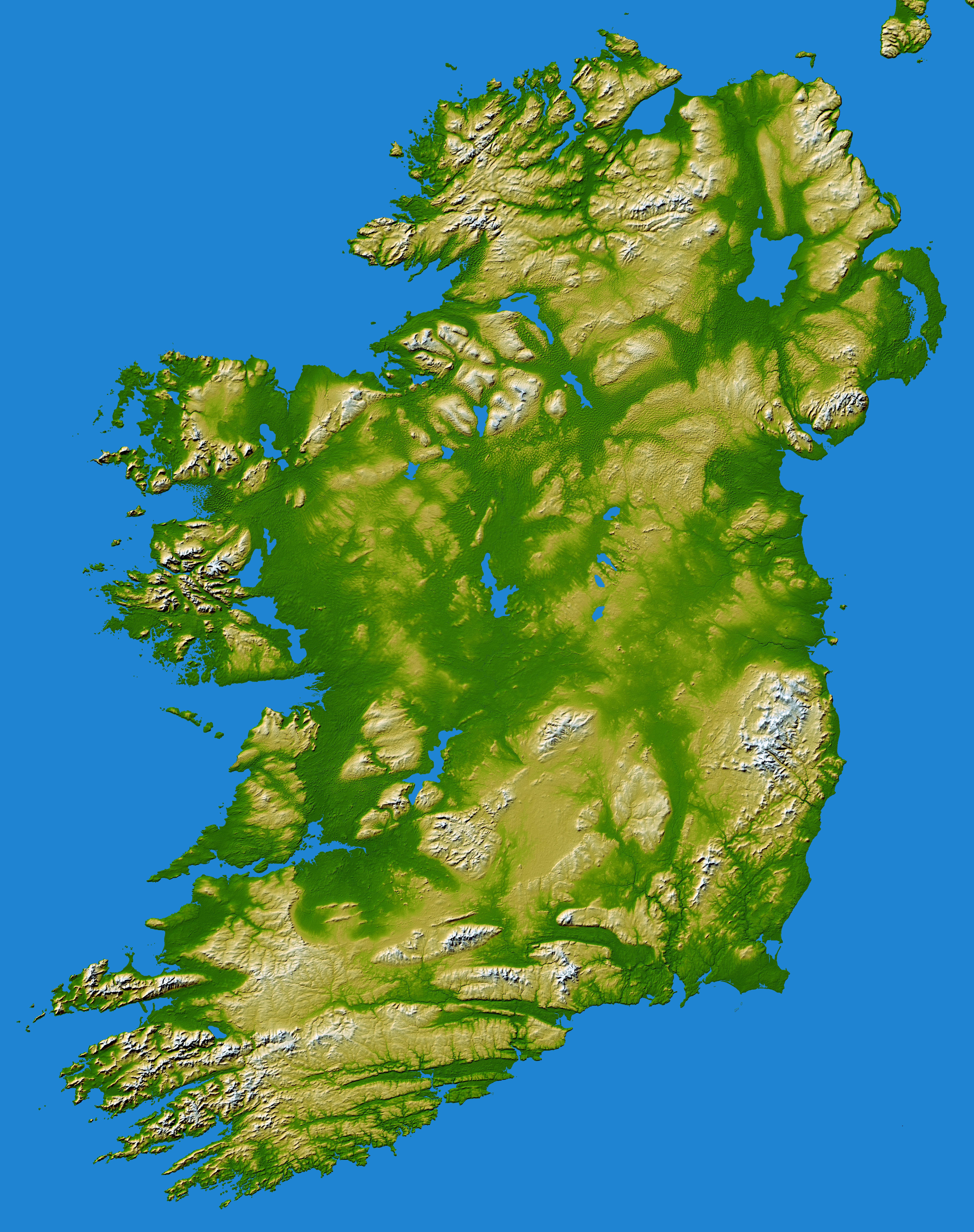|
Cruach Mhór
Cruach Mhór (Irish language, Irish for "big stack"), at high, is the tenth-highest peak in Ireland on the Lists of mountains in Ireland#Arderins, Arderin list, and the eleventh-highest peak in Ireland according to the Lists of mountains in Ireland#Vandeleur-Lynams, Vandeleur-Lynam list. A distinctive square ''grotto'' marks the summit. It is part of the MacGillycuddy's Reeks in County Kerry. Geography Cruach Mhór is at the far eastern section of MacGillycuddy's Reeks in County Kerry, Ireland's highest mountain range. It is the first major peak in the ''MacGillycuddy's Reeks#MacGillycuddy's Reeks Ridge Walk, MacGillycuddy's Reeks Ridge Walk'' when started from ''Kate Kearney's Cottage'' in the Gap of Dunloe. The ridge between Cruach Mhór and Cnoc na Péiste , is marked by The Big Gun at its centre, and is considered as offering some of the most exposed and serious hill walking in Ireland (equivalent to The Bones on the nearby ''Beenkeragh Ridge''). The Macgillycuddy's ... [...More Info...] [...Related Items...] OR: [Wikipedia] [Google] [Baidu] |
The Big Gun
The Big Gun (), at high, is the ninth-highest peak in Ireland on the Lists of mountains in Ireland#Arderins, Arderin list, or the tenth-highest according to the Lists of mountains in Ireland#Vandeleur-Lynams, Vandeleur-Lynam list. It is part of the MacGillycuddy's Reeks in County Kerry, and is also known as Lackagarrin or Foilnabreachaun. Geography The Big Gun is in the eastern section of the MacGillycuddy's Reeks in County Kerry, Ireland's highest mountain range. It is on a narrow rocky arête between the mountains of Cnoc na Péiste to the southwest, and Cruach Mhór to the north, and is considered as offering some of the most exposed and serious hill walking in Ireland (equivalent to The Bones on the nearby ''Beenkeragh Ridge''). Because of its positioning, The Big Gun is usually climbed as part of a ''horseshoe'', or loop-walk, of the eastern section of the Reeks, starting and ending from the ''Hag's Glen''. It is also climbed as part of the even longer ''MacGillyc ... [...More Info...] [...Related Items...] OR: [Wikipedia] [Google] [Baidu] |
Irish Times
''The Irish Times'' is an Irish daily broadsheet newspaper and online digital publication. It was launched on 29 March 1859. The editor is Ruadhán Mac Cormaic. It is published every day except Sundays. ''The Irish Times'' is Ireland's leading newspaper. It is considered a newspaper of record for Ireland. Though formed as a Protestant Irish nationalist paper, within two decades and under new owners, it became a supporter of unionism in Ireland. In the 21st century, it presents itself politically as "liberal and progressive", as well as being centre-right on economic issues. The editorship of the newspaper from 1859 until 1986 was controlled by the Anglo-Irish Protestant minority, only gaining its first nominal Irish Catholic editor 127 years into its existence. The paper's notable columnists have included writer and arts commentator Fintan O'Toole and satirist Miriam Lord. The late Taoiseach Garret FitzGerald was once a columnist. Michael O'Regan was the Leinster House ... [...More Info...] [...Related Items...] OR: [Wikipedia] [Google] [Baidu] |
DoBIH
The mountains and hills of the British Isles are categorised into various lists based on different combinations of elevation, prominence, and other criteria such as isolation. These lists are used for peak bagging, whereby hillwalkers attempt to reach all the summits on a given list, the oldest being the 282 Munros in Scotland, created in 1891. A height above 2,000 ft, or more latterly 610 m, is considered necessary to be classified as a mountain – as opposed to a hill – in the British Isles. With the exception of Munros, all the lists require a prominence above . A prominence of between (e.g. some Nuttalls and Vandeleur-Lynams), does not meet the International Climbing and Mountaineering Federation (UIAA) definition of an "independent peak", which is a threshold over . Most lists consider a prominence between as a "top" (e.g. many Hewitts and Simms). Marilyns, meanwhile, have a prominence above , with no additional height threshold. They range from small hills t ... [...More Info...] [...Related Items...] OR: [Wikipedia] [Google] [Baidu] |
List Of Furth Mountains In The British Isles
This is a list of Furth mountains in Britain and Ireland by height. Furths are defined as mountains that meet the classification criteria to be a Scottish Munro, including being over in elevation, but which are ''furth'' of (i.e. "outside" of) Scotland. They are also called Welsh Munros, Irish Munros, and English Munros respectively, or the ''three-thousanders,'' as in '' The Welsh 3000 challenge''. Some Furth definitions add a topographical prominence above , akin to a Scottish Murdo, however the official Scottish Mountaineering Club ("SMC") lists includes Furths with a prominence below this level. Applying the Real Munro definition to a Furth, requires a prominence above , akin to a Marilyn, and these 14 Furths are marked with (‡) in the tables below. The SMC lists 34 Furths: six in England, 15 in Wales, and 13 on Ireland. These compare with 282 Munros and 226 Munro Tops in Scotland. Thirty three have the in prominence to be Murdos. Fifteen have the of prominence to ... [...More Info...] [...Related Items...] OR: [Wikipedia] [Google] [Baidu] |
Cruach Mhor And The Big Gun From Cnoc Na Peiste Ridge (MacGillycuddy's Reeks)
Crom Cruach ( ) was a pagan god of pre-Christian Ireland. According to Christian writers, he was propitiated with human sacrifice and his worship was ended by Saint Patrick. He is also referred to as ''Crom Cróich'', ''Cenn Cruach''/''Cróich'' () and ''Cenncroithi'' (). He is related to the later mythological and folkloric figure Crom Dubh. The references in a '' dinsenchas'' ("place-lore") poem in the 12th century to sacrifice in exchange for milk and grain suggest that Crom had a function as a fertility god. The description of his image as a gold figure surrounded by twelve stone or bronze figures has been interpreted by some as representing the sun surrounded by the signs of the zodiac, suggesting a function as a solar deity. Name Crom Cruach's name takes several forms. ''Crom'' (or ''cromm'') means "bent, crooked, stooped" or according to O'Reilly is perhaps related to ''cruim'' meaning "thunder". ''Cenn'' means "head", and by extension "head, chief". ''Cruach'' (or ... [...More Info...] [...Related Items...] OR: [Wikipedia] [Google] [Baidu] |
Irish Munro
This is a list of Furth mountains in Britain and Ireland by height. Furths are defined as mountains that meet the classification criteria to be a Scottish Munro, including being over in elevation, but which are ''furth'' of (i.e. "outside" of) Scotland. They are also called Welsh Munros, Irish Munros, and English Munros respectively, or the ''three-thousanders,'' as in '' The Welsh 3000 challenge''. Some Furth definitions add a topographical prominence above , akin to a Scottish Murdo, however the official Scottish Mountaineering Club ("SMC") lists includes Furths with a prominence below this level. Applying the Real Munro definition to a Furth, requires a prominence above , akin to a Marilyn, and these 14 Furths are marked with (‡) in the tables below. The SMC lists 34 Furths: six in England, 15 in Wales, and 13 on Ireland. These compare with 282 Munros and 226 Munro Tops in Scotland. Thirty three have the in prominence to be Murdos. Fifteen have the of prominence to ... [...More Info...] [...Related Items...] OR: [Wikipedia] [Google] [Baidu] |
Munro
A Munro (; ) is defined as a mountain in Scotland with a height over , and which is on the Scottish Mountaineering Club (SMC) official list of Munros; there is no explicit topographical prominence requirement. The best known Munro is Ben Nevis (Beinn Nibheis), the highest mountain in the British Isles at 4,411 ft (1,345 m). Munros are named after Sir Hugh Munro, 4th Baronet (1856–1919), who produced the first list of such hills, known as ''Munro's Tables'', in 1891. Also included were what Munro considered lesser peaks, now known as Munro Tops, which are also over 3,000 feet but are lower than the nearby primary mountain. The publication of the original list is usually considered to be the Epoch (reference date), epoch event of modern peak bagging. The list has been the subject of subsequent variation and , the Scottish Mountaineering Club has listed 282 Munros and 226 Munro Tops. "Munro bagging" is the activity of climbing all the listed Munros. , 7,654 people had rep ... [...More Info...] [...Related Items...] OR: [Wikipedia] [Google] [Baidu] |
Scottish Mountaineering Club
Established in 1889, the Scottish Mountaineering Club is a club for climbing and mountaineering in Scotland. History The Scottish Mountaineering Club (SMC) was formed in Glasgow, Scotland, in March 1889, as one of Scotland's first mountaineering clubs. The club was initially proposed by William W. Naismith, William Wilson Naismith, a Scottish accountant and mountaineer, who published a letter in the ''The Herald (Glasgow), Glasgow Herald'' in January 1889 that suggested establishing a Scottish version of the Alpine Club. According to club records, the object of the SMC was: The purpose of the SMC was to document the exploration of the Scottish Highlands and its local flora and fauna. Soon after its inception, the SMC began publishing the ''Scottish Mountaineering Club Journal'' in 1890. The Journal provided their members and other alpine groups with lists of accommodations, guidebooks and maps of climbing areas. In 1945, the SMC joined the British Mountaineer Council, a coalitio ... [...More Info...] [...Related Items...] OR: [Wikipedia] [Google] [Baidu] |
Database Of British And Irish Hills
The mountains and hills of the British Isles are categorised into various lists based on different combinations of elevation, prominence, and other criteria such as isolation. These lists are used for peak bagging, whereby hillwalkers attempt to reach all the summits on a given list, the oldest being the 282 Munros in Scotland, created in 1891. A height above 2,000 ft, or more latterly 610 m, is considered necessary to be classified as a mountain – as opposed to a hill – in the British Isles. With the exception of Munros, all the lists require a prominence above . A prominence of between (e.g. some Nuttalls and Vandeleur-Lynams), does not meet the International Climbing and Mountaineering Federation (UIAA) definition of an "independent peak", which is a threshold over . Most lists consider a prominence between as a "top" (e.g. many Hewitts and Simms). Marilyns, meanwhile, have a prominence above , with no additional height threshold. They range from small hills to ... [...More Info...] [...Related Items...] OR: [Wikipedia] [Google] [Baidu] |
List Of Mountains Of The British Isles By Height
This article provides access to lists of mountains in Britain and Ireland by height and by prominence. (See Lists of mountains below.) Height and prominence are the most important metrics for the classifications of mountains by the UIAA; with isolation a distant third criterion. The list is sourced from the '' Database of British and Irish Hills'' ("DoBIH") for peaks that meet the consensus height threshold for a mountain, namely ; the list also rules out peaks with a prominence below and thus, the list is therefore precisely a list of the 2,756 Simms in the British Isles (as at October 2022). Many classifications of mountains in the British Isles consider a prominence between as being a "top", and not a mountain; however, using the prominence threshold gives the broadest possible list of mountains. For a ranking of mountains with a higher prominence threshold use: * List of Marilyns in the British Isles, for ranking by height and by prominence, of peaks with prominence ov ... [...More Info...] [...Related Items...] OR: [Wikipedia] [Google] [Baidu] |
MountainViews Online Database
In these lists of mountains in Ireland, those within Northern Ireland, or on the Republic of Ireland – United Kingdom border, are marked with an asterisk, while the rest are within the Republic of Ireland. Where mountains are ranked by height, the definition of the topographical prominence used to classify the mountain (e.g. the change in elevation required between neighbouring mountains), is noted. In British definitions, a height of is required for a mountain, whereas in Ireland, a lower threshold of is sometimes advocated. The lowest minimum prominence threshold of any definition of an Irish mountain is (e.g. the Lists of mountains and hills in the British Isles#Vandeleur-Lynams, Vandeleur-Lynam), however most definitions, including the International Climbing and Mountaineering Federation (UIAA) criteria, do not consider prominences below as being mountains (e.g. must at least be an Lists of mountains and hills in the British Isles#Arderins, Arderin or a Lists of mounta ... [...More Info...] [...Related Items...] OR: [Wikipedia] [Google] [Baidu] |
Grotto Of Cruach Mhor
A grotto or grot is a natural or artificial cave or covered recess. Naturally occurring grottoes are often small caves near water that are usually flooded or often flooded at high tide. Sometimes, artificial grottoes are used as garden features. The '' Grotta Azzurra'' at Capri and the grotto at Tiberius' Villa Jovis in the Bay of Naples are examples of popular natural seashore grottoes. Etymology The word ''grotto'' comes from Italian ''grotta'', Vulgar Latin ''grupta'', and Latin ''crypta'' ("a crypt"). It is also related by a historical accident to the word ''grotesque''. In the late 15th century, Romans accidentally unearthed Nero's ''Domus Aurea'' on the Palatine Hill—a series of rooms, decorated with designs of garlands, slender architectural framework, foliage, and animals. The rooms had sunk underground over time. The Romans who discovered this historical monument found it very strange, partly because it was uncovered from an "underworld" source. This led the Rom ... [...More Info...] [...Related Items...] OR: [Wikipedia] [Google] [Baidu] |







